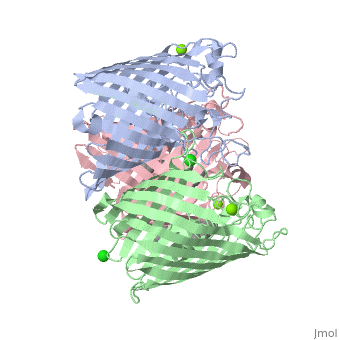2j1n: Difference between revisions
No edit summary |
No edit summary |
||
| Line 2: | Line 2: | ||
<StructureSection load='2j1n' size='340' side='right' caption='[[2j1n]], [[Resolution|resolution]] 2.00Å' scene=''> | <StructureSection load='2j1n' size='340' side='right' caption='[[2j1n]], [[Resolution|resolution]] 2.00Å' scene=''> | ||
== Structural highlights == | == Structural highlights == | ||
<table><tr><td colspan='2'>[[2j1n]] is a 3 chain structure with sequence from [http://en.wikipedia.org/wiki/ | <table><tr><td colspan='2'>[[2j1n]] is a 3 chain structure with sequence from [http://en.wikipedia.org/wiki/"bacillus_coli"_migula_1895 "bacillus coli" migula 1895]. Full crystallographic information is available from [http://oca.weizmann.ac.il/oca-bin/ocashort?id=2J1N OCA]. For a <b>guided tour on the structure components</b> use [http://oca.weizmann.ac.il/oca-docs/fgij/fg.htm?mol=2J1N FirstGlance]. <br> | ||
</td></tr><tr id='ligand'><td class="sblockLbl"><b>[[Ligand|Ligands:]]</b></td><td class="sblockDat"><scene name='pdbligand=CL:CHLORIDE+ION'>CL</scene>, <scene name='pdbligand=D12:DODECANE'>D12</scene>, <scene name='pdbligand=MG:MAGNESIUM+ION'>MG</scene></td></tr> | </td></tr><tr id='ligand'><td class="sblockLbl"><b>[[Ligand|Ligands:]]</b></td><td class="sblockDat"><scene name='pdbligand=CL:CHLORIDE+ION'>CL</scene>, <scene name='pdbligand=D12:DODECANE'>D12</scene>, <scene name='pdbligand=MG:MAGNESIUM+ION'>MG</scene></td></tr> | ||
<tr id='resources'><td class="sblockLbl"><b>Resources:</b></td><td class="sblockDat"><span class='plainlinks'>[http://oca.weizmann.ac.il/oca-docs/fgij/fg.htm?mol=2j1n FirstGlance], [http://oca.weizmann.ac.il/oca-bin/ocaids?id=2j1n OCA], [http://www.rcsb.org/pdb/explore.do?structureId=2j1n RCSB], [http://www.ebi.ac.uk/pdbsum/2j1n PDBsum]</span></td></tr> | <tr id='resources'><td class="sblockLbl"><b>Resources:</b></td><td class="sblockDat"><span class='plainlinks'>[http://oca.weizmann.ac.il/oca-docs/fgij/fg.htm?mol=2j1n FirstGlance], [http://oca.weizmann.ac.il/oca-bin/ocaids?id=2j1n OCA], [http://pdbe.org/2j1n PDBe], [http://www.rcsb.org/pdb/explore.do?structureId=2j1n RCSB], [http://www.ebi.ac.uk/pdbsum/2j1n PDBsum]</span></td></tr> | ||
</table> | </table> | ||
== Function == | == Function == | ||
| Line 26: | Line 26: | ||
From MEDLINE®/PubMed®, a database of the U.S. National Library of Medicine.<br> | From MEDLINE®/PubMed®, a database of the U.S. National Library of Medicine.<br> | ||
</div> | </div> | ||
<div class="pdbe-citations 2j1n" style="background-color:#fffaf0;"></div> | |||
==See Also== | ==See Also== | ||
| Line 34: | Line 35: | ||
__TOC__ | __TOC__ | ||
</StructureSection> | </StructureSection> | ||
[[Category: | [[Category: Bacillus coli migula 1895]] | ||
[[Category: Basle, A]] | [[Category: Basle, A]] | ||
[[Category: Rosenbusch, J P]] | [[Category: Rosenbusch, J P]] | ||
Revision as of 04:05, 12 September 2015
OSMOPORIN OMPCOSMOPORIN OMPC
Structural highlights
Function[OMPC_ECOLI] Forms pores that allow passive diffusion of small molecules across the outer membrane. Evolutionary Conservation Check, as determined by ConSurfDB. You may read the explanation of the method and the full data available from ConSurf. Publication Abstract from PubMedPorins form transmembrane pores in the outer membrane of Gram-negative bacteria with matrix porin OmpF and osmoporin OmpC from Escherichia coli being differentially expressed depending on environmental conditions. The three-dimensional structure of OmpC has been determined to 2.0 A resolution by X-ray crystallography. As expected from the high sequence similarity, OmpC adopts the OmpF-like 16-stranded hollow beta-barrel fold with three beta-barrels associated to form a tight trimer. Unlike in OmpF, the extracellular loops form a continuous wall at the perimeter of the vestibule common to the three pores, due to a 14-residues insertion in loop L4. The pore constriction and the periplasmic outlet are very similar to OmpF with 74% of the pore lining residues being conserved. Overall, only few ionizable residues are exchanged at the pore lining. The OmpC structure suggests that not pore size, but electrostatic pore potential and particular atomic details of the pore linings are the critical parameters that physiologically distinguish OmpC from OmpF. Crystal structure of osmoporin OmpC from E. coli at 2.0 A.,Basle A, Rummel G, Storici P, Rosenbusch JP, Schirmer T J Mol Biol. 2006 Oct 6;362(5):933-42. Epub 2006 Aug 3. PMID:16949612[1] From MEDLINE®/PubMed®, a database of the U.S. National Library of Medicine. See AlsoReferences
|
| ||||||||||||||||
